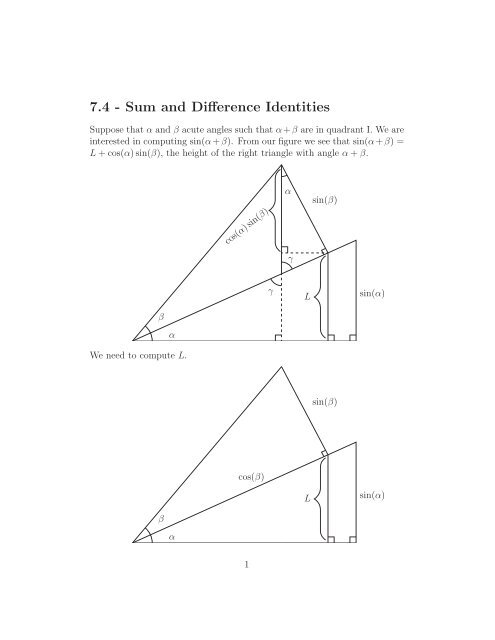7.4 - Sum and Difference Identities
7.4 - Sum and Difference Identities
7.4 - Sum and Difference Identities
You also want an ePaper? Increase the reach of your titles
YUMPU automatically turns print PDFs into web optimized ePapers that Google loves.
<strong>7.4</strong> - <strong>Sum</strong> <strong>and</strong> <strong>Difference</strong> <strong>Identities</strong><br />
Suppose that α <strong>and</strong> β acute angles such that α+β are in quadrant I. We are<br />
interested in computing sin(α+β). From our figure we see that sin(α+β) =<br />
L+cos(α)sin(β), the height of the right triangle with angle α+β.<br />
β<br />
α<br />
We need to compute L.<br />
β<br />
α<br />
cos(α)sin(β)<br />
cos(β)<br />
1<br />
γ<br />
α<br />
γ<br />
L<br />
L<br />
sin(β)<br />
sin(β)<br />
sin(α)<br />
sin(α)
L<br />
Bysimilartrianglesweseethat<br />
Hence we have<br />
sin(α)<br />
= cos(β)<br />
1 <strong>and</strong>thereforeL = sin(α)cos(β).<br />
sin(α+β) = cos(α)sin(β)+sin(α)cos(β).<br />
<strong>Sum</strong> <strong>and</strong> <strong>Difference</strong> <strong>Identities</strong><br />
We have established the following result.<br />
Theorem 1.<br />
cos(a±b) = cos(a)cos(b)∓sin(a)sin(b)<br />
sin(a±b) = sin(a)cos(b)±cos(a)sin(b)<br />
tan(a±b) = tan(a)±tan(b)<br />
1∓tan(a)tan(b)<br />
Example 1. Findcos(α+β),giventhatα<strong>and</strong>β areinquadrantIII,cos(α) =<br />
−3 12 , <strong>and</strong> tan(β) = 5 5 .<br />
We have cos(α) = − 3<br />
5<br />
−12<br />
−3<br />
−4<br />
α<br />
5<br />
−5<br />
13<br />
5<br />
, sin(α) = −4,<br />
cos(β) = − 5 13<br />
cos(α+β) = cos(α)cos(β)−sin(α)sin(β) =<br />
β<br />
<br />
− 3<br />
5<br />
<br />
− 5<br />
13<br />
<strong>and</strong> sin(β) = −12<br />
13 ,<br />
<br />
− − 4<br />
<br />
−<br />
5<br />
12<br />
13<br />
Example 2. Use a trig formula to find the exact value for the expression<br />
tan <br />
π . 12<br />
2<br />
<br />
.
We have<br />
Example 3. Verify<br />
We have<br />
<br />
π<br />
<br />
π<br />
tan = tan<br />
12 3<br />
= tan π<br />
3<br />
=<br />
π<br />
<br />
−<br />
4 <br />
π −tan 4<br />
1+tan <br />
π π<br />
tan 3 4<br />
√<br />
3−1<br />
1+ √ 3 .<br />
sin(x+y) tan(x)+tan(y)<br />
=<br />
sin(x−y) tan(x)−tan(y) .<br />
sin(x+y) sin(x)cos(y)+sin(y)cos(x)<br />
=<br />
sin(x−y) sin(x)cos(y)−sin(y)cos(x)<br />
=<br />
=<br />
sin(x)cos(y)+sin(y)cos(x)<br />
cos(x)cos(y)<br />
sin(x)cos(y)−sin(y)cos(x)<br />
cos(x)cos(y)<br />
sin(x)<br />
cos(x)<br />
+ sin(y)<br />
cos(y)<br />
sin(x) sin(y)<br />
− cos(x) cos(y)<br />
= tan(x)+tan(y)<br />
tan(x)−tan(y) .<br />
Example 4. Show that cos(x+2π) = cos(x).<br />
By the angle addition formula we get<br />
cos(x+2π) = cos(x)cos(2π)−sin(x)sin(2π) = cos(x).<br />
Co-Function <strong>Identities</strong><br />
The co-function identities are given by<br />
<br />
π<br />
sin<br />
2 −x<br />
<br />
π<br />
= cos(x) cos<br />
2 −x<br />
<br />
π<br />
= sin(x) tan<br />
2 −x<br />
<br />
= cot(x)<br />
<br />
π<br />
csc<br />
2 −x<br />
<br />
π<br />
= sec(x) sec<br />
2 −x<br />
<br />
π<br />
= csc(x) cot<br />
2 −x<br />
<br />
= tan(x).<br />
3
Example 5. Express csc( π<br />
2<br />
−x) in term of sec.<br />
<br />
π<br />
csc<br />
2 −x<br />
<br />
= sec(x).<br />
Example 6. Express sin(3x) in terms of cos.<br />
<br />
π<br />
sin(3x) = cos<br />
2 −3x<br />
<br />
.<br />
Example 7. Find <br />
x−2<br />
cos arctan .<br />
x<br />
Now<br />
tan(θ) = x−2<br />
x<br />
implies that the hypotenuse of the triangle is x2 +(x−2) 2 .<br />
Therefore cos(θ) =<br />
An Application<br />
x−2<br />
√ x<br />
x2 +(x−2) 2 .<br />
x 2 +(x−2) 2<br />
x<br />
Example 8. Sound is a result of waves applying pressure to a person’s<br />
eardrum. Foraparticularwaveradiatingoutward, thetrigonometricfunction<br />
P(r) = a cos(πr−1000t) can be used to express pressure at a radius of r feet<br />
r<br />
from the source after t seconds. In this formula, a is the maximum sound<br />
pressure at the source, measured in pounds per square foot.<br />
Use a difference identity to simplify the expression for P(r) when r is an<br />
even integer.<br />
We get<br />
cos(rπ −1000t) = cos(rπ)cos(1000t)+sin(rπ)sin(1000t)<br />
<strong>and</strong> if r is even we have rπ = 0,2π,4π,... <strong>and</strong> therefore<br />
cos(2kπ−1000t) = cos(1000t).<br />
4<br />
θ
Extra problems<br />
1. If a person with weight W bends at the waist with a straight back, then<br />
the force F exerted by the lower back muscles may be approximated<br />
using F = 2.89W sin(θ+90 ◦ ), where θ is the angle between a person’s<br />
torso <strong>and</strong> the horizontal. Approximate the value of θ that will cause a<br />
130 pound person’s back muscles to exert a force of 200 pounds.<br />
2. Given cos(s) = − 15<br />
<strong>and</strong> cos(t) = −4,<br />
<strong>and</strong> that s <strong>and</strong> t are in quadrant<br />
17 5<br />
II, find sin(s+t),cos(s+t),tan(s+t) <strong>and</strong> the quadrant of s+t.<br />
3. Find the angle of intersection, θ, for lines l1 <strong>and</strong> l2 if their slopes are<br />
given by tan(α) <strong>and</strong> tan(β) <strong>and</strong> show that θ satisfies the following,<br />
where α <strong>and</strong> β are acute angles.<br />
Khan Academy Video Links<br />
Proof of sin(a+b)<br />
Proof of cos(a+b)<br />
tan(θ) = tan(β)−tan(α)<br />
1+tan(α)tan(β)<br />
5

















